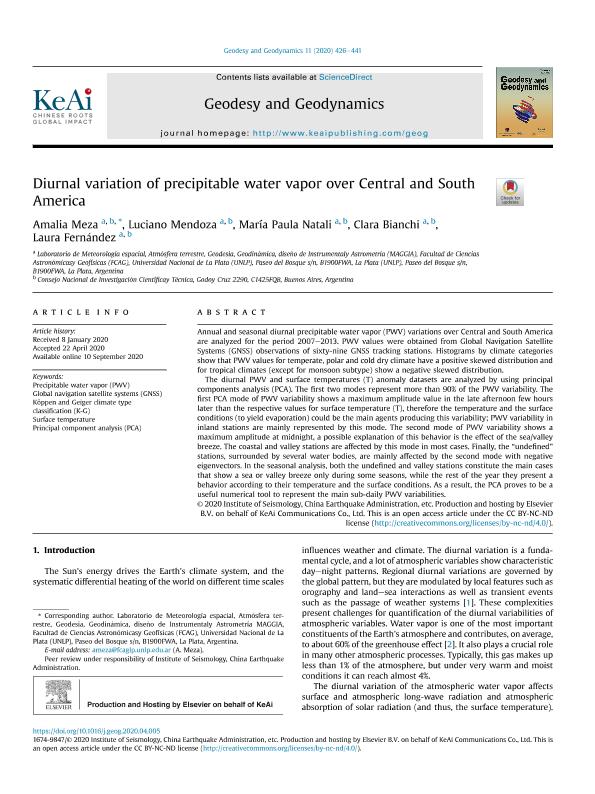Mostrar el registro sencillo del ítem
dc.contributor.author
Meza, Amalia Margarita

dc.contributor.author
Mendoza, Luciano Pedro Oscar

dc.contributor.author
Natali, Maria Paula

dc.contributor.author
Bianchi, Clara Eugenia

dc.contributor.author
Fernandez, Laura Isabel

dc.date.available
2021-09-01T16:44:07Z
dc.date.issued
2020-11
dc.identifier.citation
Meza, Amalia Margarita; Mendoza, Luciano Pedro Oscar; Natali, Maria Paula; Bianchi, Clara Eugenia; Fernandez, Laura Isabel; Diurnal variation of precipitable water vapor over Central and South America; KeAi Communications Co.; Geodesy and Geodynamics; 11; 6; 11-2020; 426-441
dc.identifier.issn
1674-9847
dc.identifier.uri
http://hdl.handle.net/11336/139435
dc.description.abstract
Annual and seasonal diurnal precipitable water vapor (PWV) variations over Central and South America are analyzed for the period 2007–2013. PWV values were obtained from Global Navigation Satellite Systems (GNSS) observations of sixty-nine GNSS tracking stations. Histograms by climate categories show that PWV values for temperate, polar and cold dry climate have a positive skewed distribution and for tropical climates (except for monsoon subtype) show a negative skewed distribution. The diurnal PWV and surface temperatures (T) anomaly datasets are analyzed by using principal components analysis (PCA). The first two modes represent more than 90% of the PWV variability. The first PCA mode of PWV variability shows a maximum amplitude value in the late afternoon few hours later than the respective values for surface temperature (T), therefore the temperature and the surface conditions (to yield evaporation) could be the main agents producing this variability; PWV variability in inland stations are mainly represented by this mode. The second mode of PWV variability shows a maximum amplitude at midnight, a possible explanation of this behavior is the effect of the sea/valley breeze. The coastal and valley stations are affected by this mode in most cases. Finally, the “undefined” stations, surrounded by several water bodies, are mainly affected by the second mode with negative eigenvectors. In the seasonal analysis, both the undefined and valley stations constitute the main cases that show a sea or valley breeze only during some seasons, while the rest of the year they present a behavior according to their temperature and the surface conditions. As a result, the PCA proves to be a useful numerical tool to represent the main sub-daily PWV variabilities.
dc.format
application/pdf
dc.language.iso
eng
dc.publisher
KeAi Communications Co.
dc.rights
info:eu-repo/semantics/openAccess
dc.rights.uri
https://creativecommons.org/licenses/by-nc-nd/2.5/ar/
dc.subject
GLOBAL NAVIGATION SATELLITE SYSTEMS (GNSS)
dc.subject
KÖPPEN AND GEIGER CLIMATE TYPE CLASSIFICATION (K-G)
dc.subject
PRECIPITABLE WATER VAPOR (PWV)
dc.subject
PRINCIPAL COMPONENT ANALYSIS (PCA)
dc.subject
SURFACE TEMPERATURE
dc.subject.classification
Meteorología y Ciencias Atmosféricas

dc.subject.classification
Ciencias de la Tierra y relacionadas con el Medio Ambiente

dc.subject.classification
CIENCIAS NATURALES Y EXACTAS

dc.title
Diurnal variation of precipitable water vapor over Central and South America
dc.type
info:eu-repo/semantics/article
dc.type
info:ar-repo/semantics/artículo
dc.type
info:eu-repo/semantics/publishedVersion
dc.date.updated
2021-08-13T16:53:08Z
dc.journal.volume
11
dc.journal.number
6
dc.journal.pagination
426-441
dc.journal.pais
China

dc.description.fil
Fil: Meza, Amalia Margarita. Universidad Nacional de La Plata. Facultad de Ciencias Astronómicas y Geofísicas. Laboratorio Maggia; Argentina. Consejo Nacional de Investigaciones Científicas y Técnicas. Centro Científico Tecnológico Conicet - La Plata; Argentina
dc.description.fil
Fil: Mendoza, Luciano Pedro Oscar. Universidad Nacional de La Plata. Facultad de Ciencias Astronómicas y Geofísicas. Laboratorio Maggia; Argentina. Consejo Nacional de Investigaciones Científicas y Técnicas. Centro Científico Tecnológico Conicet - La Plata; Argentina
dc.description.fil
Fil: Natali, Maria Paula. Universidad Nacional de La Plata. Facultad de Ciencias Astronómicas y Geofísicas. Laboratorio Maggia; Argentina. Consejo Nacional de Investigaciones Científicas y Técnicas. Centro Científico Tecnológico Conicet - La Plata; Argentina
dc.description.fil
Fil: Bianchi, Clara Eugenia. Universidad Nacional de La Plata. Facultad de Ciencias Astronómicas y Geofísicas. Laboratorio Maggia; Argentina. Consejo Nacional de Investigaciones Científicas y Técnicas. Centro Científico Tecnológico Conicet - La Plata; Argentina
dc.description.fil
Fil: Fernandez, Laura Isabel. Universidad Nacional de La Plata. Facultad de Ciencias Astronómicas y Geofísicas. Laboratorio Maggia; Argentina. Consejo Nacional de Investigaciones Científicas y Técnicas. Centro Científico Tecnológico Conicet - La Plata; Argentina
dc.journal.title
Geodesy and Geodynamics
dc.relation.alternativeid
info:eu-repo/semantics/altIdentifier/url/https://www.sciencedirect.com/science/article/pii/S1674984720300719
dc.relation.alternativeid
info:eu-repo/semantics/altIdentifier/doi/http://dx.doi.org/10.1016/j.geog.2020.04.005
Archivos asociados
